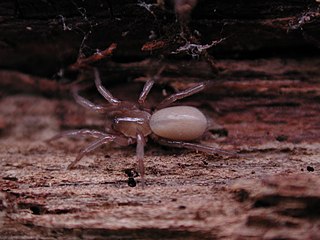
The Agelenidae are a large family of spiders in the suborder Araneomorphae. Well-known examples include the common "grass spiders" of the genus Agelenopsis. Nearly all Agelenidae are harmless to humans, but the bite of the hobo spider may be medically significant, and some evidence suggests it might cause necrotic lesions, but the matter remains subject to debate. The most widely accepted common name for members of the family is funnel weaver.

Kukulcania is a genus of crevice weavers that was first described by Pekka T. Lehtinen in 1967. It is named after Kukulkan, a Mesoamerican serpent deity.

Psilochorus is a genus of spiders in the family Pholcidae.

Metepeira is a genus of orb-weaver spiders first described by F. O. Pickard-Cambridge in 1903. The name is derived from the Ancient Greek μετά and the obsolete genus name Epeira, denoting a genus similar to Epeira.
Melpomene is a genus of funnel weavers first described by O. Pickard-Cambridge in 1898. They range from southwestern U.S. to Panama and can grow up to 7 to 8.5 millimetres long. Roth and Brame noted that, with many undescribed species, the genus appears to be a catchall or "wastebasket taxon" for several unrelated species that may represent several genera.

Cicurina, also called the cave meshweaver, is a genus of dwarf sheet spiders that was first described by Anton Menge in 1871. Originally placed with the funnel weavers, it was moved to the Dictynidae in 1967, then to the Hahniidae in 2017. The name is from the Latin root "cucur-", meaning "to tame".

Dictyna is a genus of cribellate araneomorph spiders in the family Dictynidae, and was first described by Carl Jakob Sundevall in 1833.
Spirembolus is a genus of North American sheet weavers that was first described by Ralph Vary Chamberlin in 1920.
Calilena is a genus of North American funnel weavers first described by R. V. Chamberlin & Wilton Ivie in 1941.

Hololena is a genus of North American funnel weavers first described by R. V. Chamberlin & Willis J. Gertsch in 1929.

Novalena is a genus of North American and Caribbean funnel weavers first described by R. V. Chamberlin & Wilton Ivie in 1942.

Emblyna is a genus of cribellate araneomorph spiders in the family Dictynidae, and was first described by R. V. Chamberlin in 1948.
Yorima is a genus of araneomorph spiders in the family Cybaeidae and was first described by R. V. Chamberlin & Wilton Ivie in 1942. Originally placed in the funnel weaver family, it was moved to the Dictynidae in 1967, and to the Cybaeidae in 2017.

Calymmaria is a genus of North American araneomorph spiders in the family Cybaeidae, and was first described by R. V. Chamberlin & Wilton Ivie in 1937. They have body lengths ranging from 2 to 10 millimetres.
Linyphantes is a genus of North American dwarf spiders that was first described by Ralph Vary Chamberlin & Vaine Wilton Ivie in 1942.

Phrurotimpus is a genus of araneomorph spiders first described by R. V. Chamberlin and Wilton Ivie in 1935. The name is a compound adjective meaning "guarding the stone". Originally added to the Liocranidae, it was moved to the Corinnidae in 2002, then to the Phrurolithidae in 2014. They have red egg sacs that look like flattened discs, often found on the underside of stones.










